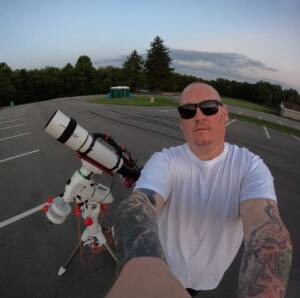
Discovery of the M31 [OIII] emission arc
Recently, a major discovery by an international team of amateur astronomers and scientists has become a huge online hit, and this new discovery is just located in one of the

Nigel Latham was born in 1954 and lived all of his life in the Midlands, UK. In his younger years, he worked as a disco DJ, making a lot of his equipment himself due to also being interested in electronics. After this, he began to work as an electrical engineer, mainly working on car stereos. Eventually, he moved into an IT role providing support for bespoke software. His last position before retiring due to progressing health issues was working as an IT Technician at a local school.
His main hobby for most of his life was photography. He tried all types such as models, scenery and still life.
The last 10 years were tough for Nigel. His health problems worsened and made it difficult for him to do the things he loved. He passed away peacefully in March and awaits in the stars. He is deeply missed by his wife, Lesley and his two sons, Richard and Stephen.
Due to his declining health and mobility, no longer capable of getting out and about to take scenic photography, he looked for a way to continue and evolve his hobby into something new. At first, this came in the form of still life photography. This took him many hours of preparation for every photograph, which in a way prepared him for the patience required in astrophotography.
I am not sure what sparked the idea of pointing the camera at the stars, but I am very glad it happened.
Absolutely. I would sometimes just sit and watch him, listening as he told me about the various objects he was attempting to image. I could tell from the way he was explaining what he was doing, he was extremely passionate about astrophotography and I believe he definitely enjoyed having the company.

Being in the UK, as you can imagine at many times of the year clear nights were few and far between. While I am sure he felt frustrated at times, he used that time wisely to improve and optimize his workflow and setup. For example, making custom length cables to make sure everything was neat and tidy. He also spent a lot of time making preparations and learning new techniques so when a clear night came along, it would not go to waste.

I believe astrophotography set him free. He was a person of routine. Always in bed for 10 pm. After he started the hobby, he would be up until 2, 3 or even 4 in the morning. It was a more adventurous side I had never seen before.



I am not sure of his personal favourite, but the one I would pick would be the Eagle Nebula, home to the Pillars of Creation. It’s such an iconic object and it makes it even better knowing that he imaged it himself. I am not sure on what equipment he used for this.
Earliest finished work I can find is the Orion Nebula from November 2018.
The most recent one he completed before he passed was coincidentally the Orion Nebula once again in February 2022.
The difference speaks for itself on how much he improved over a few years.
He did and was very proud to do so. The vast majority of interactions with other astrophotographers were through various online groups and we were not aware of any local groups at the time.
It was the main thing we spoke about. Whenever I asked him what he was working on, it was usually testing a new feature or reporting bugs. He was extremely excited whenever a new firmware version was released, especially if it fixed an issue that he had reported. When he found out his name would be printed on the booklet for the ASIAR Plus, we were both extremely proud of the work he had done.

He was the friendliest and laid-back person you could ever meet. He was so enthusiastic about his hobbies and was a pleasure to be around.
Apart from his regular photography, he enjoyed listening to music immensely. He would listen every night and in his spare time, he would add to and organize his large music collection accumulated over many years.
“From Earth to the Stars: Nigel’s Story”

Recently, a major discovery by an international team of amateur astronomers and scientists has become a huge online hit, and this new discovery is just located in one of the

Hello,Sara Harvey,thanks for accepting our interview invitation. Congratulations on winning the ASIWEEK competition in week! Q1: At first, congratulation that your nice image won #ASIWEEK. Can you introduce yourself to

Astrophotography is more than just capturing images of the night sky—it’s a journey of discovery, patience, and creativity. For this passionate astrophotographer, what started as a chance encounter with a

Taranjot Singh, an Indian origin Australian astrophotographer who is making waves on the international stage. Taranjot has been recognized as one of the Top 5 finalists in the prestigious Siena

The back focal length is advised by telescope manufacturers. Since most telescopes have a 55mm back focal length, we are here to provide detailed instructions for all ASI cooled cameras.Please

How to connect ASI6200MM Pro to 2″ EFW/M54 filter drawer and OAG-L? How many solutions are there for ASI6200MM Pro to get 55mm back focus length? If you are still